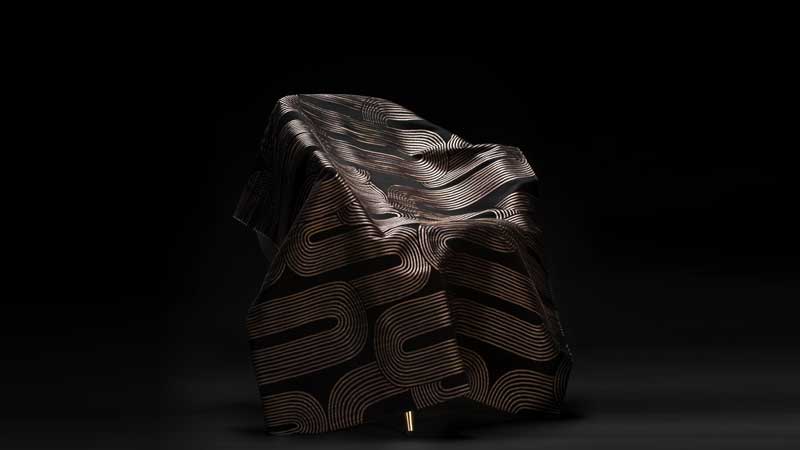
Innovations in smart fabrics for home
Sachin Chauhan says, with emerging developments in technology, more interesting smart fabrics can be expected in the future.
You have heard of smart home technology that offers complete control of running and maintaining an environment, while also taking care of the safety of the property from remote. In an inter-connected world, all you need is a smartphone to operate it. Now, smart fabrics are revolutionizing home interiors beyond imagination. Think stain-resistant, fire-resistant, anti-bacterial and self-cleaning fabrics! Think fabrics that change colour like chameleons, and offer a lot more advantages. Ground-breaking innovations in home textiles are transforming the future of home décor in a way we never envisioned possible.
The home textile industry was already making huge strides in employing technology to create novel products that ensured superior comfort, luxury and user-friendliness. The industry has been using 3D printing to create designs that spell unprecedented customisation. Clever chemical treatments, new fibres and innovative blends of fabrics have further enriched the home décor segment.
Now, the futuristic concepts governing the smart fabrics enable responsive living, enhancing comfort through intuitive technology.
Interactive and colour-changing fabrics engage the senses, transforming home textiles into dynamic and ever-evolving elements. Amid all these advancements, sustainability has been a significant element that has been on the mind of textile designers, manufacturers and buyers alike. Eco-friendly, recyclable and self-cleaning textiles signify a more sustainable and low-maintenance living. Sustainable materials like organic cotton, hemp, recycled fibres and other ethically sourced home textiles cater to the specific needs of eco-conscious customers.
Going forward, the realm of home textiles is set to become even more exciting and dynamic as innovations continue to uncover the stupendous potential cutting-edge technology offers.
Low-maintenance living
A few years ago, stain-resistant and self-cleaning fabrics seemed like a far-fetched dream. But technology has made it possible. Add to this, anti-bacterial and water-proof qualities, and you have magical fabrics that offer astonishing functional advantages.
Furniture upholstery that repels dust, stain and moisture not only leads you towards a low-maintenance living, but also towards a more sustainable lifestyle as the environmental impact comes down considerably. These smart fabrics are especially ideal for upholstery in commercial, hospitality and hotel industries.
Responsive textiles
Technological advancements are being used to create intelligent environments that constantly elevate lifestyles by offering extraordinary comforts and benefits. Imagine upholstery that adjusts to body movements, bed linen that regulates temperature according to your preference. And, how about curtains that adapt to sunlight and offer UV-proofing using nano technology! These intuitive fabrics are tailored to improve human well-being.
Sensorial experience
Home textiles are no longer inert materials, but ever-transforming features in a space. Smart fabrics offer interactive experiences through embedded sensors. They respond to human touch and movement, and also change colours based on factors like light and temperature. Some of the luxury fabrics deodorise the room, thus adding not just to the décor but also to the entire sensorial experience. There are also sound absorbing fabrics that can be used as curtains or partitions to reduce noise levels in a space, thus marrying aesthetic qualities with practical solutions.
Eco-friendly smart fabrics
With more and more consumers seeking eco-conscious interior solutions, there is an increased demand for sustainable fibres such as organic cotton, bamboo, hemp and recycled materials in textile production. Technology aids in better use of recycled and upcycled materials, allowing for their integration into luxury environments.
High personalisation with 3D printing

By employing 3D printing technology in textile design, today you can create unique textiles that showcase intricate and highly customised details. When used for upholstery and wall coverings, these fabrics spell ultimate exclusivity and luxury. With creativity and utmost precision, 3D technology allows you to tailor your interiors into highly distinctive and individualistic environments.
Also, 3D weaving technique for curtains and upholstery is being used along with laser cut perforations, so that sunlight streaming into a room can be regulated.
Light-emitting fabrics

Some smart fabrics made using fibre optics can emit light according to your requirement. The fabric can emit light continuously for a long time without getting heated. What’s more, the technology can work in connection with a sensor or can be monitored using a mobile app. Use it as luminous upholstery for sofas and chairs, or for creating illuminated cushions and curtains. They can be easily installed just like any other upholstery fabric.
Apart from these, there are many fantastic fabrics that offer unique stylistic and functional benefits. For instance, a new material has been created by combining textile and glass, where woven textile or mesh is placed between two laminated glass sheets. This material can be used for doors, screens and partitions, as well as furniture.
With emerging developments in technology, more interesting smart fabrics can be expected in the future. And it is not just about functionality, home textiles have undergone transformation in the aesthetics department as well, leading to captivating interiors.
About the author:

Carrying forward a formidable legacy, Sachin Chauhan, Director, Nirmals Furnishings, keeps bringing new ideas and insights that ensure the renowned brand is at the vanguard of creativity and innovation at all times. Having joined the family business 20 years ago, he has taken keen and holistic interest in every aspect of the brand building. Even though the soft furnishings industry is known as a goods industry, he believed that it should be more service-driven from the start. And that changed everything. He likes to interact with his clients and understand their needs and get his vendors to undertake developments based on that.




